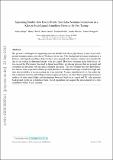Separating double-beta decay events from solar neutrino interactions in a kiloton-scale liquid scintillator detector by fast timing
Author(s)
Elagin, Andrey; Frisch, Henry J; Naranjo, Brian; Ouellet, Jonathan; Winslow, Lindley; Wongjirad, Taritree; ... Show more Show less
DownloadSubmitted version (769.8Kb)
Terms of use
Metadata
Show full item recordAbstract
© 2016 Elsevier B.V. We present a technique for separating nuclear double beta decay (ββ-decay) events from background neutrino interactions due to 8B decays in the sun. This background becomes dominant in a kiloton-scale liquid-scintillator detector deep underground and is usually considered as irreducible due to an overlap in deposited energy with the signal. However, electrons from 0νββ-decay often exceed the Cherenkov threshold in liquid scintillator, producing photons that are prompt and correlated in direction with the initial electron direction. The use of large-area fast photodetectors allows some separation of these prompt photons from delayed isotropic scintillation light and, thus, the possibility of reconstructing the event topology. Using a simulation of a 6.5 m radius liquid scintillator detector with 100 ps resolution photodetectors, we show that a spherical harmonics analysis of early-arrival light can discriminate between 0νββ-decay signal and 8B solar neutrino background events on a statistical basis. Good separation will require the development of a slow scintillator with a 5 ns risetime.
Date issued
2017Department
Massachusetts Institute of Technology. Department of PhysicsJournal
Nuclear Instruments and Methods in Physics Research, Section A: Accelerators, Spectrometers, Detectors and Associated Equipment
Publisher
Elsevier BV
Citation
Elagin, Andrey, et al. "Separating Double-Beta Decay Events from Solar Neutrino Interactions in a Kiloton-Scale Liquid Scintillator Detector by Fast Timing." Nuclear Instruments & Methods in Physics Research Section a-Accelerators Spectrometers Detectors and Associated Equipment 849 (2017): 102-11.
Version: Original manuscript